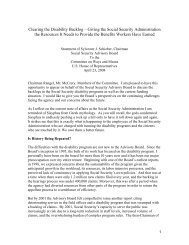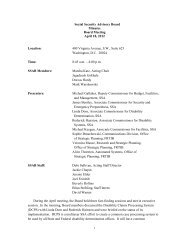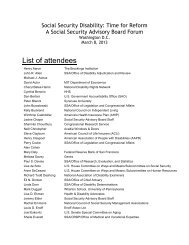grids were developed to provide a framework fordetermining whether the claimant’s functionalabilities, in combination with age, education, <strong>and</strong>work experience, significantly limit the number <strong>of</strong>jobs that he or she may be capable <strong>of</strong> performing.SSA published the grids in 1979 using vocationaldata supported by major government publications,such as the U.S. Department <strong>of</strong> Labor’s Dictionary<strong>of</strong> Occupational Titles.The vocational grids direct a finding <strong>of</strong> disabledor not disabled only when all <strong>of</strong> the criteria<strong>of</strong> a specific rule are met. For example, accordingto Vocational Rule 201.03, a claimant who islimited to sedentary work because <strong>of</strong> physicalimpairments, is <strong>of</strong> advanced age (55 or older), <strong>and</strong>has a limited education (11th grade or less) will befound not disabled provided the previous work wasskilled or semi-skilled <strong>and</strong> those skills are transferableto a new job setting.The medical-vocational guidelines, which arebased solely on the capacity for physical exertion,function as reference points, or guidingprinciples, for cases involving severe non-exertionalimpairments. If a claimant’s impairmentis non-exertional (e.g., postural, manipulative, orenvironmental restrictions; mental impairment)or if he or she has a combination <strong>of</strong> exertional<strong>and</strong> non-exertional limitations, the vocationalrules will not direct the conclusion <strong>of</strong> the claim.Instead, the adjudicator will use the guiding principlesto evaluate the facts <strong>of</strong> the case. This is <strong>of</strong>tena difficult area for adjudicators <strong>and</strong> results in moresubjective decision making.When SSA developed the grids, the agencycalculated the number <strong>of</strong> unskilled jobs that existin the national economy at different functionallevels (sedentary, light, medium, heavy, <strong>and</strong> veryheavy). Non-exertional limitations impact on thenumber <strong>of</strong> jobs (range <strong>of</strong> work) that an individualis able to do at the different functional levels. Inthe example cited above, the grids direct a finding<strong>of</strong> not disabled for the claimant with exertionallimitations restricting him or her to sedentarywork. If, however, the same claimant also hassignificant limitations <strong>of</strong> fingering <strong>and</strong> feeling (anon-exertional limitation), the decision outcomemay change. Since fingering is needed to performmost unskilled sedentary jobs <strong>and</strong> to perform certainskilled <strong>and</strong> semiskilled jobs at all exertionallevels, the adjudicator will have to determinewhether there are jobs “in significant numbers”that the claimant can do.In claims reaching this stage <strong>of</strong> the sequentialprocess, vocational issues are the most complicated.When making their decision, adjudicatorsrely primarily on the Dictionary <strong>of</strong> OccupationalTitles (DOT) <strong>and</strong> other companion publications. 5In some DDSs, disability examiners have access toa vocational specialist <strong>and</strong> may request assistancefrom that individual in a difficult case. At the hearinglevel, the administrative law judge may requestthe testimony <strong>of</strong> a vocational expert in casesinvolving complicated vocational issues.The percentage <strong>of</strong> DI claims awarded by Stateagencies on the basis <strong>of</strong> vocational factors hasnearly tripled, increasing from 18 percent <strong>of</strong> allawards in 1983 to 54 percent in 2010. Denialsbased on the claimant’s ability to perform usualwork have risen from nearly 19 percent in 1981 to28 percent in 2010. Denials based on the ability toperform other work have increased from 11 percentin 1981 to 35 percent in 2010.5The Dictionary <strong>of</strong> Occupational Titles was last updated in 1991<strong>and</strong> is no longer maintained by the Department <strong>of</strong> Labor. Manyjobs listed in the DOT no longer exist, <strong>and</strong> others, like many computerjobs, do not appear in the DOT. SSA, however, continues touse it as one <strong>of</strong> its sources <strong>of</strong> data about job requirements in thenational economy. Because this information is fundamental tothe sequential evaluation process <strong>and</strong> SSA’s medical-vocationalregulations, the agency has convened an expert panel to research<strong>and</strong> make recommendations that will enable SSA to developan occupational information system suited to its disabilityprograms.86 <strong>Aspects</strong> <strong>of</strong> <strong>Disability</strong> <strong>Decision</strong> <strong>Making</strong>: <strong>Data</strong> <strong>and</strong> <strong>Materials</strong>
B. Steps in the Social Security <strong>Disability</strong> Application <strong>and</strong> Appeals ProcessesInitial ApplicationField Office RoleA claimant files an application for SocialSecurity <strong>Disability</strong> Insurance (DI) <strong>and</strong>Supplemental Security Income (SSI) disabilitybenefits in one <strong>of</strong> SSA’s 1,300 field <strong>of</strong>fices. Theapplication asks for information that will enableSSA staff to determine whether the claimantmeets the non-disability requirements for entitlement.For DI cases, these requirements includesuch factors as whether the claimant is insured fordisability benefits. In SSI cases, individuals mustprovide pro<strong>of</strong> <strong>of</strong> citizenship status <strong>and</strong> documentation<strong>of</strong> their income <strong>and</strong> resources.The field <strong>of</strong>fice is also responsible for obtaininginformation from the claimant about his orher impairment <strong>and</strong> how it limits the ability todo work. Information about the claimant’s medicalsources, tests, <strong>and</strong> medications is collected, aswell as information about the individual’s pastwork, education <strong>and</strong> training. The accuracy <strong>and</strong>completeness <strong>of</strong> the information on this “disabilityreport” can influence whether the claimant’sapplication is approved or denied <strong>and</strong> affects thespeed in which the decision is made.Claimants generally rely on field <strong>of</strong>fice staffto advise them <strong>and</strong> their representatives on whattypes <strong>of</strong> evidence to submit to support their claims.SSA developed a “disability claim starter kit” thatis sent out in advance <strong>of</strong> the interview <strong>and</strong> providesthe claimant with preparatory materials forthe interview. The claimant or the representativecan complete the forms <strong>and</strong> worksheets <strong>and</strong> takethem or mail them to the field <strong>of</strong>fice, or use theInternet to transmit the information. Telephoneinterviews <strong>and</strong> disability reports filed over theInternet now comprise a growing number <strong>of</strong> theapplications filed. As a result, fewer applicants areactually being seen in the field <strong>of</strong>fices.DDS RoleAfter securing the disability report, the SSAfield <strong>of</strong>fice sends it to a <strong>Disability</strong> DeterminationServices (DDS), a State-run agency that makes disabilitydeterminations using SSA’s regulations <strong>and</strong>procedures. There, a team consisting <strong>of</strong> a disabilityevaluation specialist <strong>and</strong> a physician (or psychologist)considers the facts in the case <strong>and</strong> determineswhether the claimant is disabled under the SocialSecurity rules. While the State agencies are notunder SSA’s direct administrative control, SSAfully funds their costs <strong>and</strong> provides oversight.DDSs follow the SSA-established program st<strong>and</strong>ards<strong>and</strong> their decisions are subject to qualityassurance review.The claimant is required to establish that he orshe is disabled by providing medical <strong>and</strong> other evidence<strong>of</strong> a disabling condition. The DDS, however,is responsible for making every reasonable effortto help the claimant get medical reports from theclaimant’s physicians <strong>and</strong> hospitals, clinics, orinstitutions where the person has been treated.The DDS pays a fee for any medical reports that itneeds <strong>and</strong> requests.If additional medical information is neededbefore a case can be decided, the claimant may beasked to attend a “consultative examination,” paidfor by the DDS. (SSA pays the DDS for the cost <strong>of</strong>these examinations, <strong>and</strong> for the cost <strong>of</strong> obtainingmedical reports.) This examination is importantfor those applicants who may not have a currentmedical provider or where the necessary informationis not readily available. SSA requires thatevery reasonable effort be made to obtain the evidencefrom the claimant’s treating sources before aconsultative examination is scheduled.In making a decision on a claim, the DDS conductsthe process in an informal, non-adversarialmanner. Claimants are not seen in person by theState agency adjudicators, but telephone contactsare not unusual. The claimant may present informationhe or she feels is helpful. The informationthat the claimant provides <strong>and</strong> all the evidence thatSSA <strong>and</strong> the State agency obtain from medical <strong>and</strong>other sources will be considered. The individualmay submit the information him or herself, or itmay be provided by the claimant’s representative.Once a decision is rendered, the claimantreceives a written notice. The reasons for the allowanceor the denial determination are stated in thenotice. The claimant is also informed <strong>of</strong> the rightto appeal. When a claim is approved, the awardletter shows the amount <strong>of</strong> the benefit <strong>and</strong> whenpayments start.Administrative AppealsIndividuals who receive an unfavorable initialdisability decision have the right to appeal. Thereare four levels <strong>of</strong> appeal: (1) reconsideration by theState agency; (2) hearing by an administrative lawjudge (ALJ); (3) review by the Appeals Council; <strong>and</strong>(4) Federal court review. At each level <strong>of</strong> appeal,<strong>Aspects</strong> <strong>of</strong> <strong>Disability</strong> <strong>Decision</strong> <strong>Making</strong>: <strong>Data</strong> <strong>and</strong> <strong>Materials</strong> 87









